Major cities, Indian reserves, woodlands, and soaring peaks can all be found in Arizona along with the world-famous Grand Canyon National Park and Petrified Forest National Park. The state has no shoreline, although it does have several beautiful lakes. Some of Arizona’s nicest lakes are located near major urban centers, making access to them fast and easy, which is a huge plus during a scorching hot summer day.
River damming, such as the mighty Colorado, which created Lake Mead, Lake Mohave, and Lake Havasu, has resulted in several of Arizona’s most beautiful lakes. These lakes allow outdoor enthusiasts to boat through red rock canyons, scuba dive to depths, fish for tournament-sized bass, and more around the state. Below, we will list the 12 biggest lakes in Arizona.
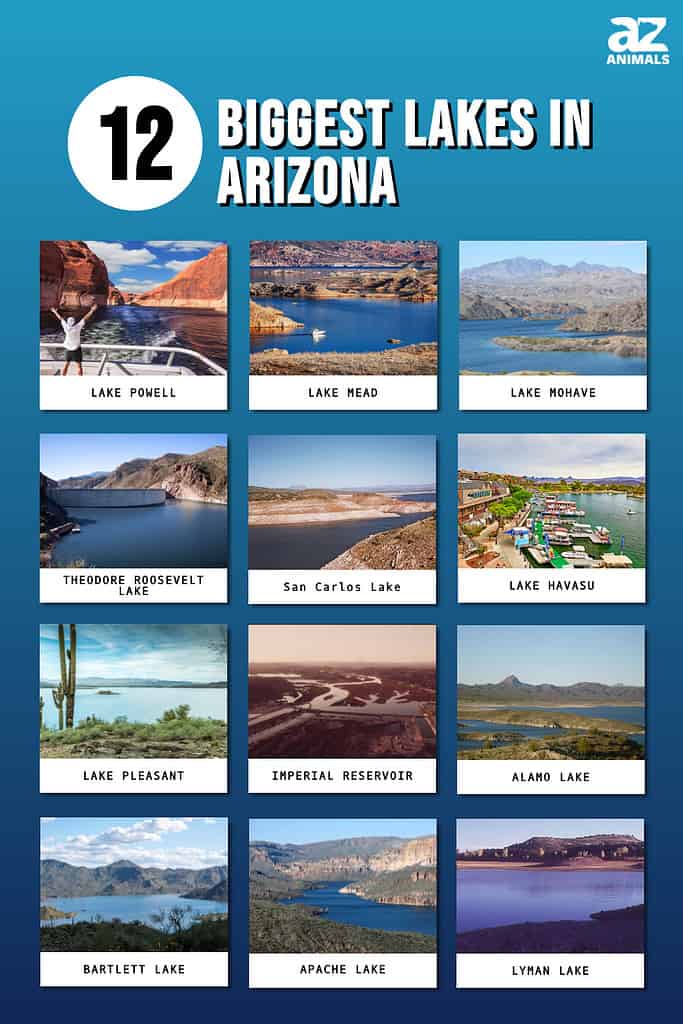
The 12 Biggest Lakes in Arizona
12. Lyman Lake
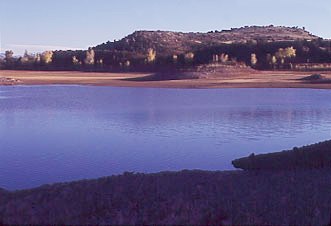
Having a surface area of 1,400 acres, the Lyman Reservoir is the 12th largest Lake in Arizona and the largest lake in the region.
©Arizona Game and Fish Department / Creative Commons – License
The Lyman Reservoir is the region’s largest lake. Anglers, campers, and water skiers go to Lyman Lake State Park, nestled in and managed by the Apache-Sitgreaves National Forest. It covers 1,400 acres (570 hectares) and reaches a maximum depth of 57 feet (17 m). With average temperatures varying from 80 to 90 degrees throughout the spring, summer, and fall, the weather here is close to perfect.
Hiking, boating, swimming, and fishing are just a few of the various recreational activities available in the park. Lyman Lake State Park encompasses the entire lake. Walleye, largemouth bass, and channel catfish are all part of the fisheries.
11. Apache Lake
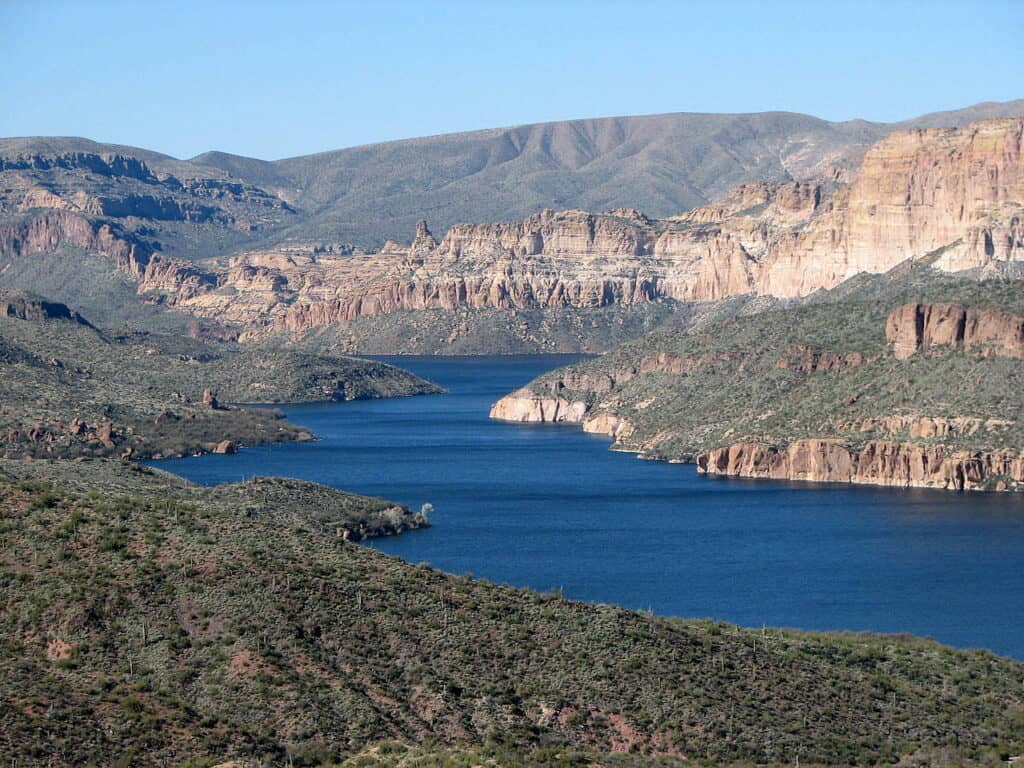
Apache Lake stretches for 17 miles and has a surface area of 2,568 acres.
©Bernard Gagnon / Creative Commons – License
Apache Lake is a reservoir along the Salt River, located 104 kilometers (65 miles) northeast of Phoenix. With 2,568 acres (1,039 hectares), Apache Lake is a well-known recreational location, with several activities available at the lake’s marina. Fishing is one of the most popular activities here, with largemouth bass, channel catfish, crappie, walleye, and sunfish being caught regularly. The scenery around the lake is unarguably breathtaking. The lake, which stretches for 17 miles, provides excellent opportunities for all types of leisure.
10. Bartlett Lake
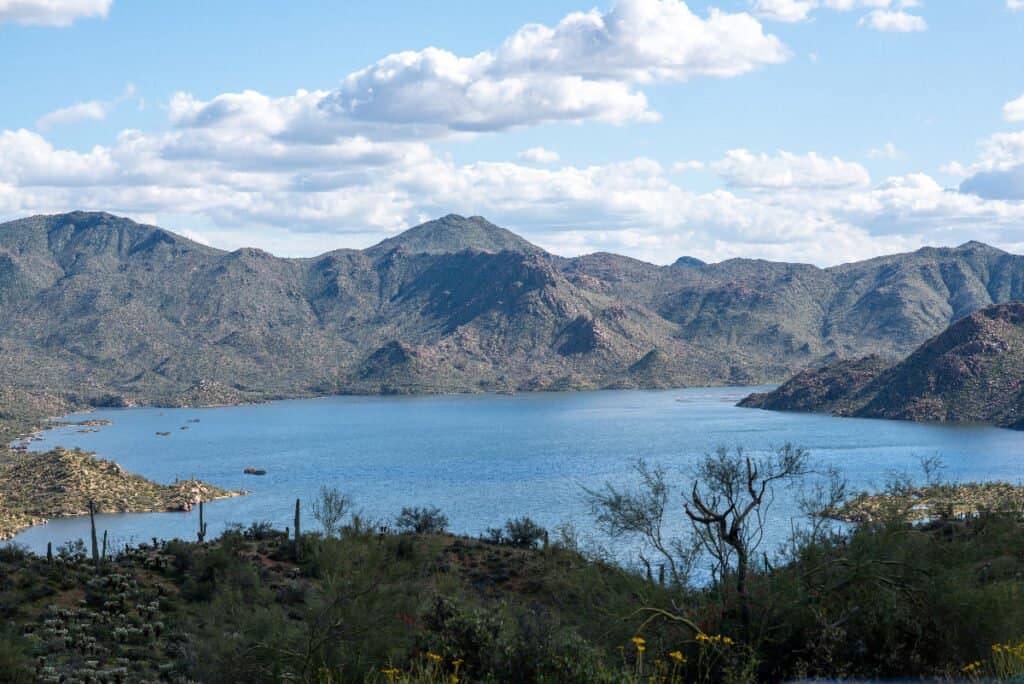
Measuring 2,815 acres, Barlett Lake is the 10th Largest Lake in Arizona.
©SED Travel Photography/Shutterstock.com
Bartlett Lake, a reservoir created by the Verde River damming, is a popular recreation location in the Tonto National Forest. It is located 48 miles (77 kilometers) from downtown Phoenix and 17 miles (27 kilometers) northeast of Carefree. The surface area of Bartlett Lake measures 2,815 acres (1,139 ha), and the maximum depth is 174 feet (53 m). Largemouth bass, smallmouth bass, channel catfish, flathead catfish, carp, crayfish, crappie, sunfish, and bullfrogs live in the lake, located at roughly 1,600 feet (490 meters) above sea level. Bartlett Lake is particularly lovely in the spring. At the same time, cacti bloom and wildflowers carpet the terrain.
9. Alamo Lake
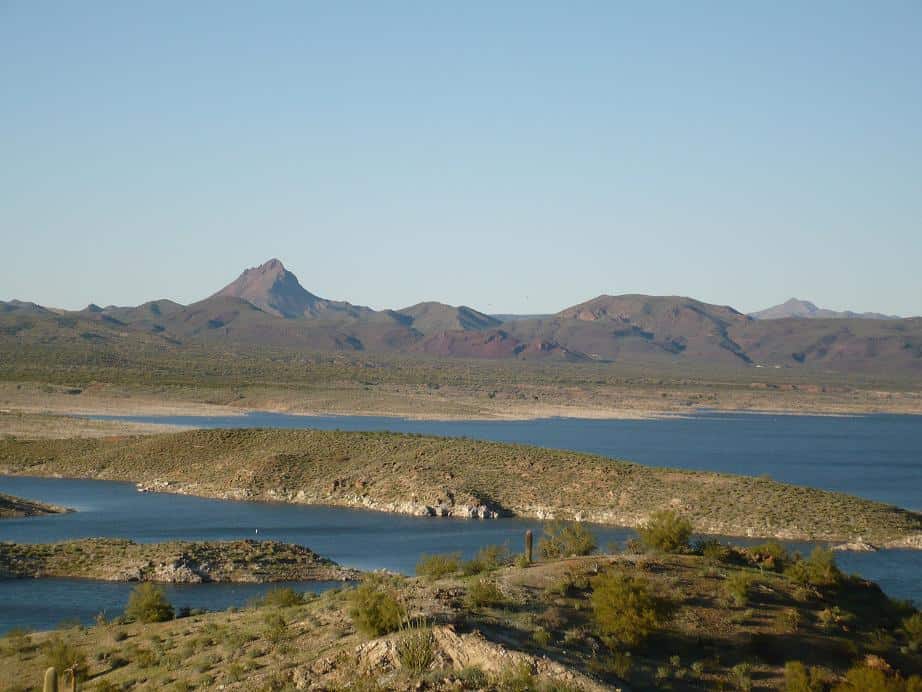
Every year, at least one of the state’s fishing records is set at Alamo Lake.
©duroc2006 / Creative Commons – License
This secluded lake, bordered by the western Arizona highlands, is regarded as one of the top bass fishing spots in the state. Alamo Lake encompasses 3,500 acres and is surrounded by the Alamo Lake State Park. It was created in 1968 for flood control concerns and is now a popular leisure destination and one of Arizona’s best fishing places. Alamo Lake is home to a plethora of crappie, sunfish, largemouth bass, channel catfish, and tilapia, making it a popular destination for fishing contests. Every year, at least one of the state’s fishing records is set at this lake. Alamo Lake also offers swimming, boating, biking, and picnicking.
8. Imperial Reservoir
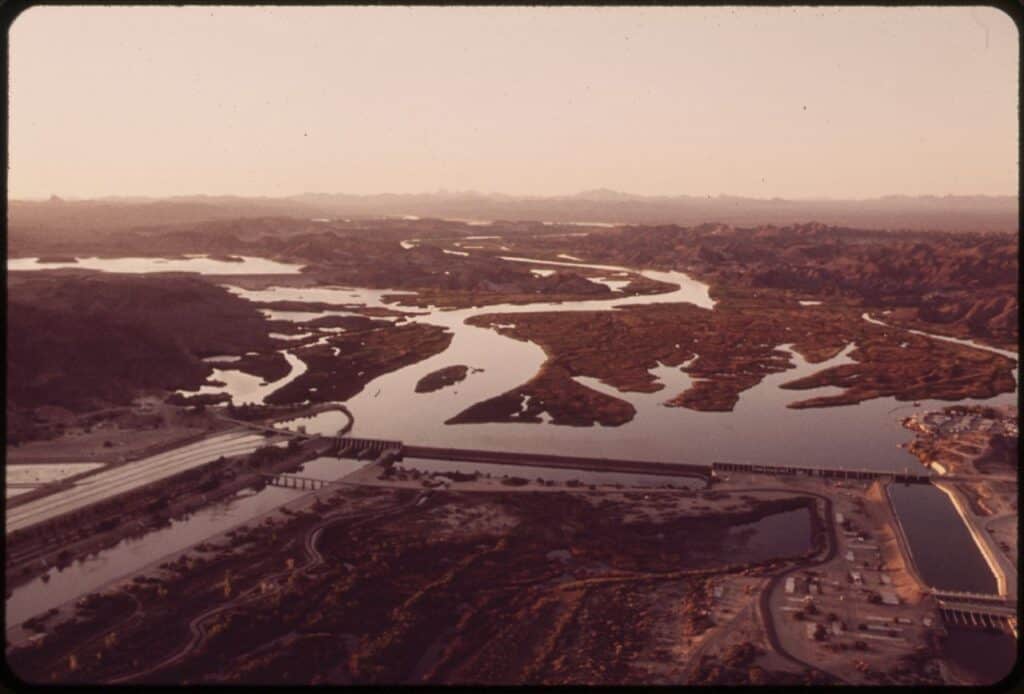
The Imperial Reservoir has a surface area of 6,918.95 acres and it holds 160,000 acres-ft of water.
©Charles O’Rear, 1941-, Photographer (NARA record: 3403717) / This image (or other media) is a work of an Environmental Protection Agency employee, taken or made as part of that person’s official duties. As works of the U.S. federal government, all EPA images are in the public domain.
The Imperial Reservoir is a man-made lake in Imperial County, California, and Yuma County, Arizona, created by the erection of the Imperial Diversion Dam across the Colorado River. It has an area of 6,918.95 acres (28 km2) and holds 160,000 acre-ft (200,000,000 m3) of water. The principal watershed supply systems to Imperial Reservoir are dry washes. The Bill Williams River, which originates in western Arizona, is the next significant watershed feeder upstream. The Havasu-Mojave Lakes Watershed of Lake Havasu is the primary feeder watershed for the Imperial Reservoir upstream on the Colorado River.
7. Lake Pleasant

Formed by the Waddell Dam, Lake Pleasant has a surface area of 7,500 acres and is 170 feet deep.
©iStock.com/Jearlwebb
Lake Pleasant is one of the nearest lakes to Phoenix, formed by the Waddell Dam on the Agua Fria River. It spans a total surface area of 7,500 acres (30 km2) and is 170 feet (52 meters) deep. During weekends, outdoor enthusiasts travel to the lake to paddleboard, boat, kayak, sail, and waterski. The lake also prides itself as one of the best inland diving spots in the West.
Lake Pleasant Regional Park, a large recreational center noted for its fantastic boating and fishing, is a great place to go if you’re searching for something different. There’s a nature center there and supper cruises and scorpion hunts at night. Largemouth bass, white bass, striped bass, crappie, sunfish, and tilapia can all be caught in the lake at night.
6. Lake Havasu
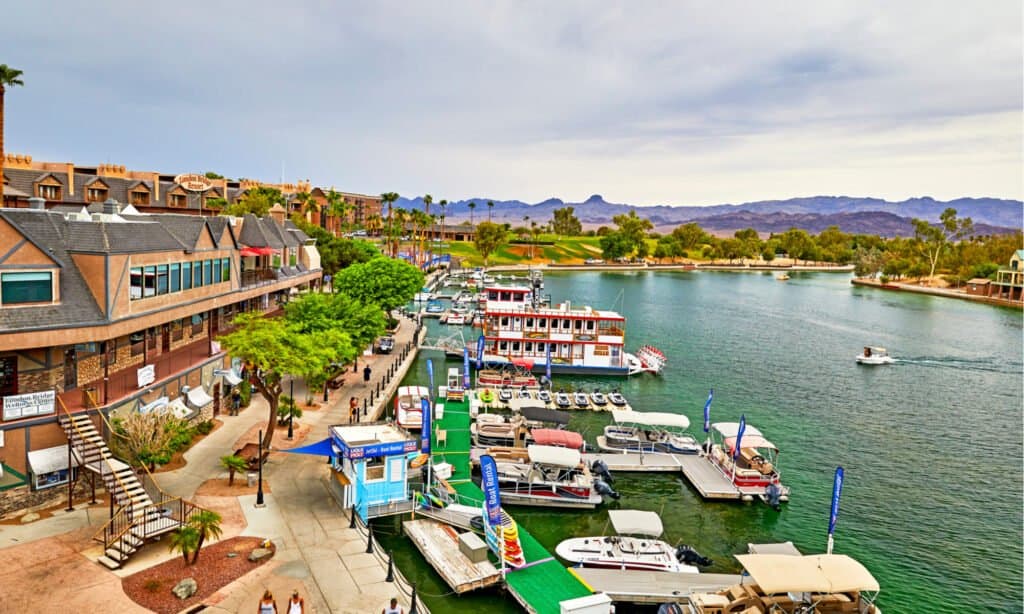
Lake Havasu is one of Arizona’s best boating lakes.
©Pamela Au/Shutterstock.com
With 60 miles of accessible waterways along the state’s northwest border, Lake Havasu is one of Arizona’s best boating lakes. It’s popular with spring breakers who flock to party on the water and the pristine shorelines of Lake Havasu State Park. It covers 19,300 acres (7,800 ha) of surface area and reaches a maximum depth of 90 feet (27 m). Throughout the summer, the lake draws numerous visitors and many snowbirds in the winter. Anglers who want to catch world-record-breaking striped, largemouth, and smallmouth bass flock to the area.
5. San Carlos Lake

Having a surface area of 19,500 acres, San Carlos Lake is the 5th largest lake in Arizona.
©No machine-readable author provided. Bobby~commonswiki assumed (based on copyright claims). / I, the copyright holder of this work, release this work into the public domain. This applies worldwide.
San Carlos Lake, with a surface size of 19,500 acres (7,900 hectares) and 158 miles of shoreline, is one of Arizona’s largest lakes. Deep blue pools are framed by slender, rocky, cactus-speckled peaks — in this case, the slopes of the Gila and Mescal mountain ranges. On the picturesque reservation, the San Carlos Recreation and Wildlife Department provides opportunities for hunting, boating, camping, fishing, birdwatching, and nature research. Cast a line to see if you can beat the state record for black crappie, largemouth bass, and flathead catfish held by the lake.
4. Theodore Roosevelt Lake
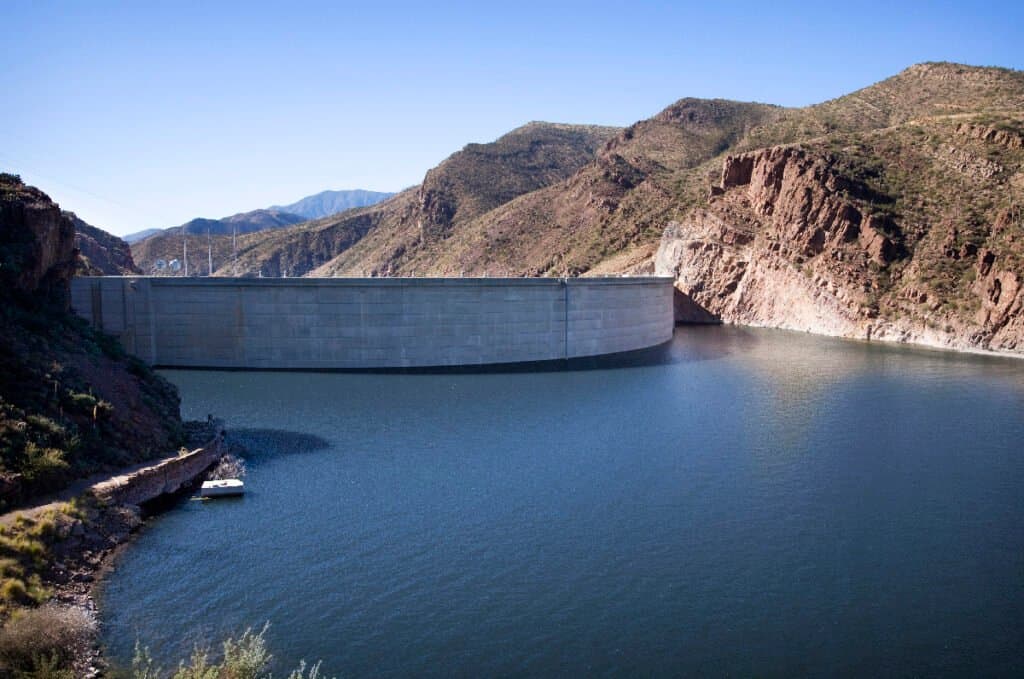
The most massive lake in Central Arizona is Theodore Roosevelt Lake.
©iStock.com/twohumans
Theodore Roosevelt Lake is a major reservoir created by the Salt River Project’s Theodore Roosevelt Dam on Arizona’s Salt River. With a surface area of 21,493 acres (8,698 ha) and a 205-kilometer (127-mile) shoreline, it is one of the state’s largest lakes and is named after the former President.
The Theodore Roosevelt Dam became the world’s largest man-made lake when it was erected in 1911. It’s still Central Arizona’s most massive lake, attracting boaters, watersports enthusiasts, and anglers looking for smallmouth and largemouth bass, crappie, and catfish. Theodore Roosevelt Lake is remarked for its excellent fishing, as it is home to a variety of gamefish. The willow flycatcher, an endangered Neotropical migrating bird, calls the lake home.
3. Lake Mohave
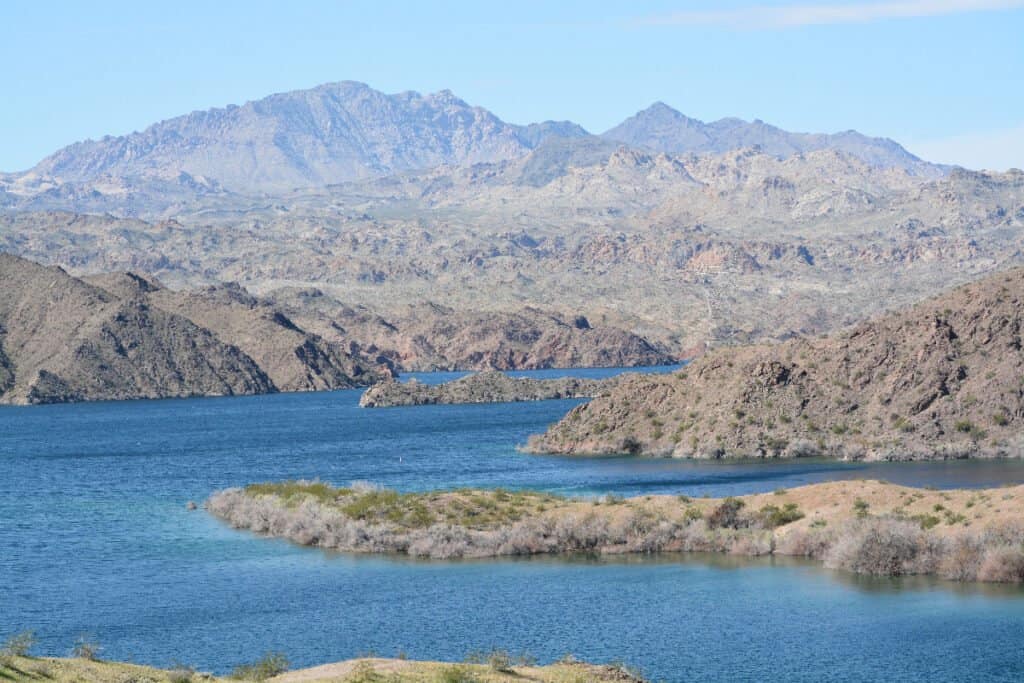
Measuring a surface area of 26,500 acres, Lake Mohave ranks as the third biggest lake in Arizona.
©Norm Lane/Shutterstock.com
Lake Mohave is a reservoir that forms the Nevada-Arizona border downstream of the Hoover Dam. The lake is less popular than Lake Mead, yet it is remarkable for its surface area of 26,500 acres (10,700 ha). It is 75 feet (23 meters) deep and has a capacity of 246.1 million cubic meters (199,500 acre-ft). The razorback sucker and the bonytail chub are two endangered native fish species found in the lake. Rainbow trout, striped bass, largemouth bass, smallmouth bass, channel catfish, crappie, common carp, and sunfish are among the main freshwater species.
The lake’s upper 22 miles are carved out of small gorges, making it a fascinating place to visit and reconnect with nature. The water is chilly up here as the lowest layers of Lake Mead continue to flow over the Hoover Dam.
2. Lake Mead
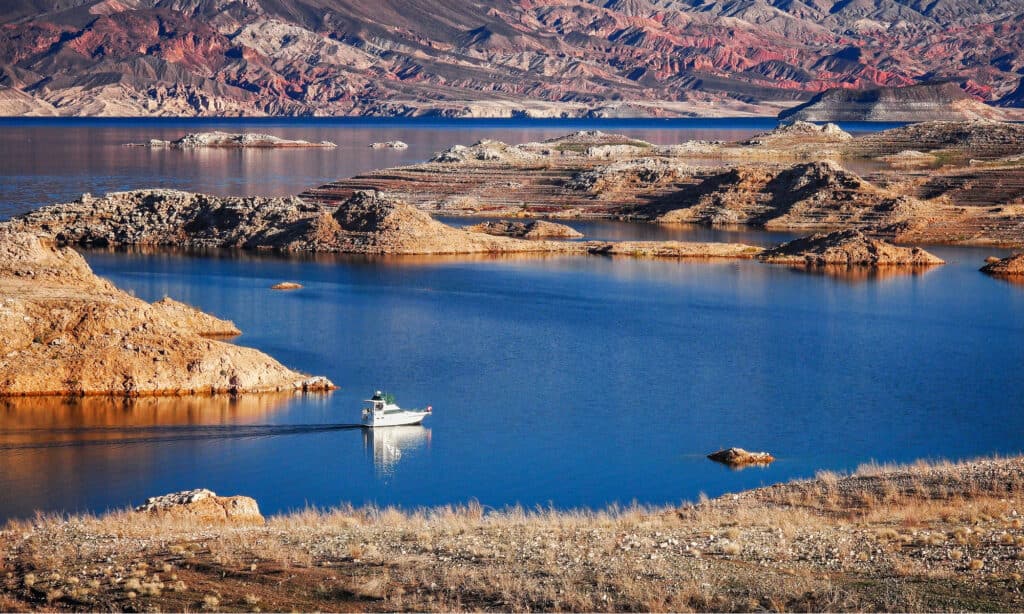
Lake Mead is the largest lake in Nevada, the largest man-made lake in the United state by volume, and the second largest lake in Arizona.
©CrackerClips Stock Media/Shutterstock.com
With a surface area of 158,100 acres, Lake Mead is the largest lake in Nevada, the largest man-made lake in the United States by volume, and the second-largest in Arizona. On the Arizona-Nevada border, Lake Mead was formed by the world-famous Hoover Dam damming the Colorado River. The reservoir was built in 1936 to provide hydroelectric power, water, recreational possibilities, and wildlife habitat.
Surrounding Lake Mead, the shoreline is a maze of shrinking valleys that lead to breathtaking views, quiet beaches, and hidden fishing holes. Despite being one of the state’s and country’s most beautiful lakes, it is also one of the most snake-infested. There are four species of rattlesnakes within the recreation area, all of which are considered deadly.
1. Lake Powell
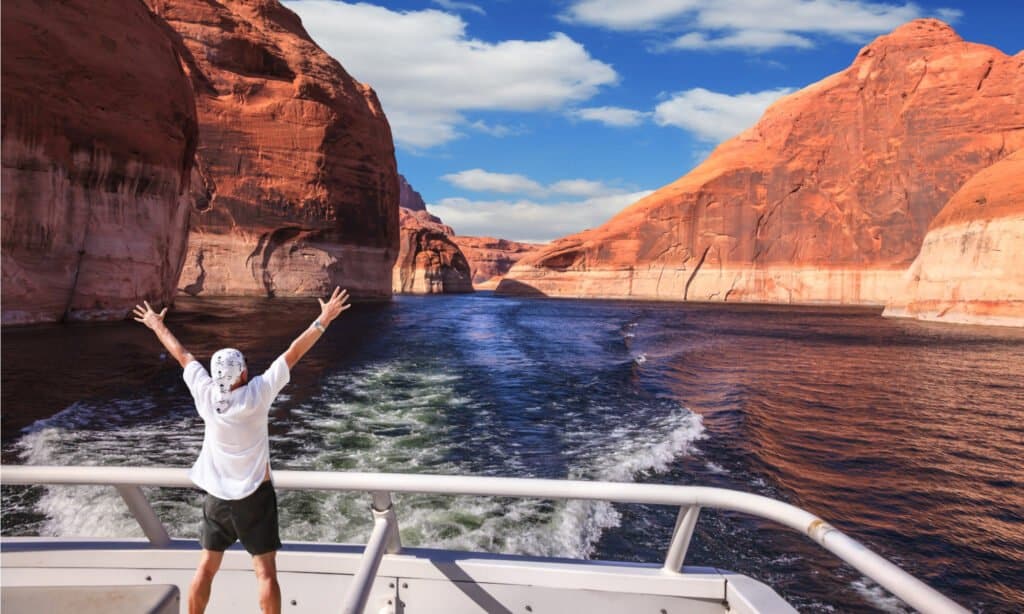
The biggest lake in Arizona is Lake Powell.
©kavram/Shutterstock.com
Lake Powell is the second-biggest reservoir in the United States by volume and the largest lake touching Arizona’s boundaries, with a total capacity of 26,214,900 acre-feet and a total surface area of 161,390 acres (65,310 hectares). In addition to providing vast water storage for the American states of Colorado, Arizona, Utah, Wyoming, and New Mexico, Lake Powell is well-known for its magnificent scenery, bringing around two million tourists and visitors each year.
Lake Powell, like Lake Mead, was formed by a dam on the Colorado River (Glen Canyon Dam). You wouldn’t need a houseboat to experience the over 2,000 miles of shoreline and 96 major canyons along the Arizona-Utah border. You may kayak, jet ski, sailboat, and waterski through the waters.
Honorable Mentions: More of the Biggest Lakes in Arizona
The three lakes below didn’t make our initial list of the biggest in Arizona but are also notable for their massive size.
Horseshoe Lake
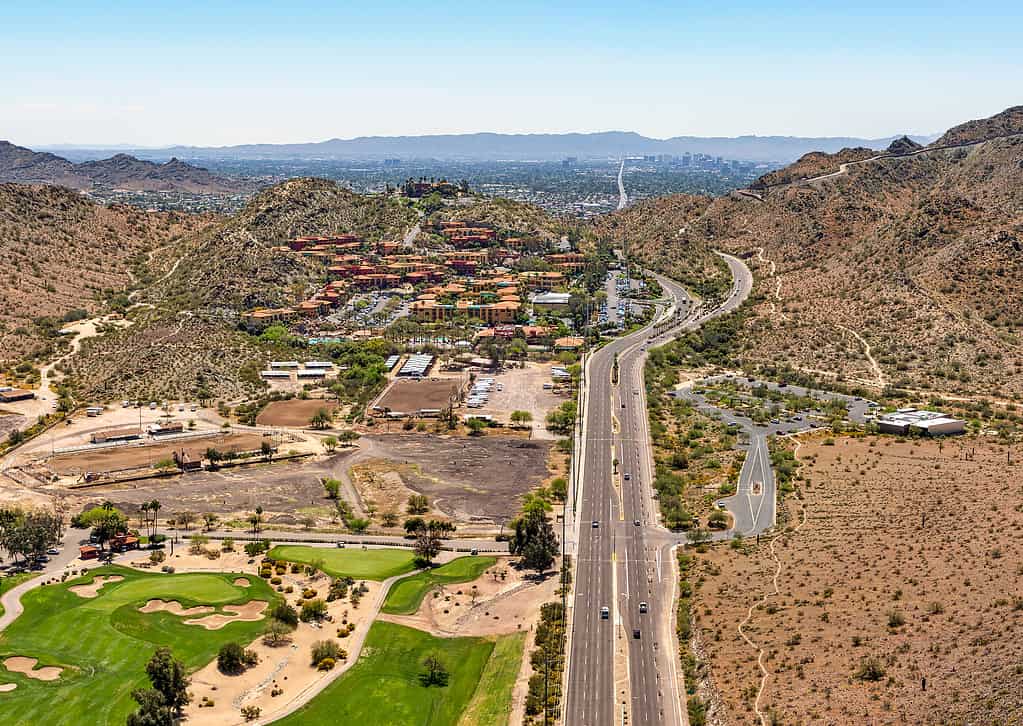
This lake is less than an hour and a half from Phoenix.
©Roberts Photography/Shutterstock.com
While Horseshoe Lake lies not too far from Phoenix, it is a lesser-known lake and not as accessible as other more popular lakes. It’s located in Tonto National Park and is the perfect place for an outing without encountering a lot of people.
It’s a manmade lake that’s stocked with fish for those who have the appropriate fishing licenses. Boating is allowed, and there are even camping opportunities at this remote destination tucked away in the Sonoran Desert.
Saguaro Lake
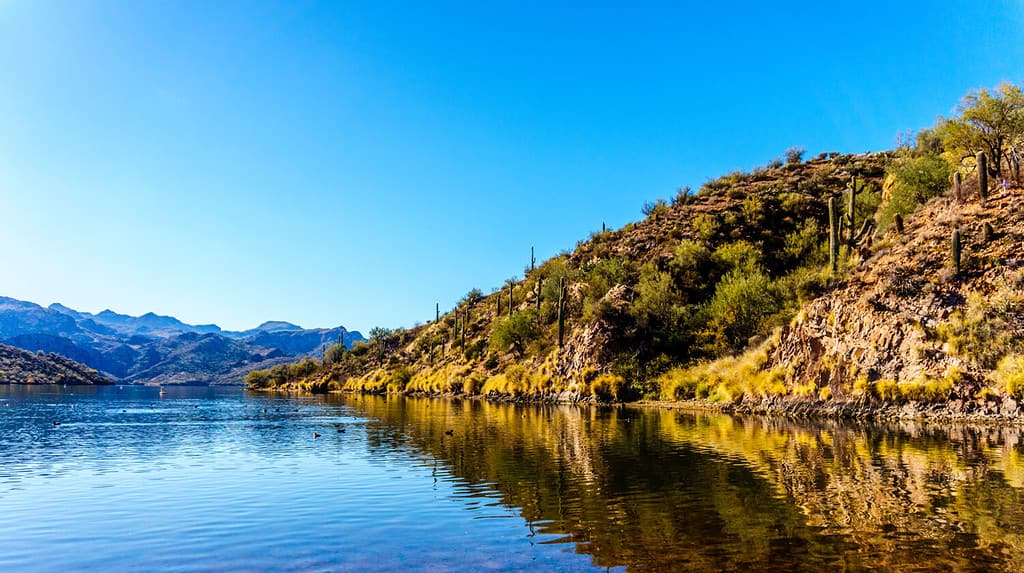
This lake is surrounded by arid desert and cacti-dotted mountains.
©Harry Beugelink/Shutterstock.com
Saguaro Lake is another of the biggest lakes in Arizona, measuring 10 miles long and spanning 1,200 acres. It’s also 110 feet deep. Its picturesque 22 miles of shoreline features granite crags, ravine walls, wetlands, and desert vegetation.
Recreational opportunities at Saguaro Lake include sailing, kayaking, canoeing, floating, yachting, waterskiing, and jet skiing. The lake is also popular among fishermen for its largemouth bass, other bass species, rainbow trout, walleye, and catfish.
Canyon Lake
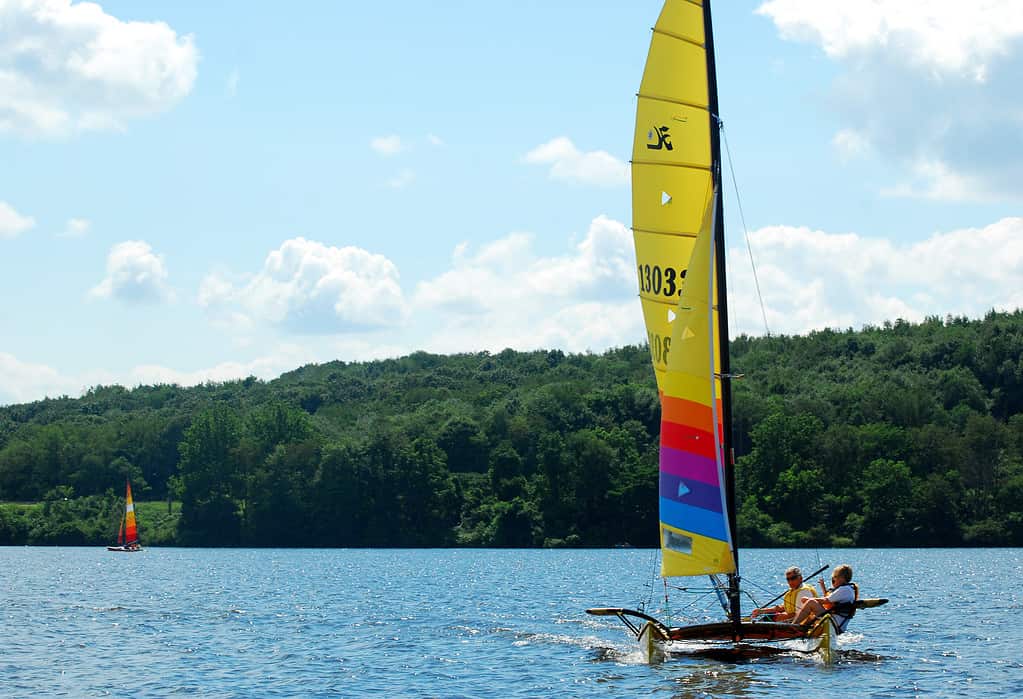
Sailing is a unique way to explore Canyon Lake.
©Rona Proudfoot, CC BY-SA 2.0 <https://creativecommons.org/licenses/by-sa/2.0>, via Wikimedia Commons – License
Canyon Lake is a reservoir situated 45 minutes east of Phoenix along the Salt River. It covers 900 acres and offers ample opportunities for recreation such as hiking, paddle boarding, sailing, kayaking, canoeing, and water skiing. Fishermen can enjoy casting their lines out for channel catfish, bluegill, crappie, large- and smallmouth bass, and walleye. The red-rock canyon walls are also known as an area to possibly view bighorn sheep.
Summary of the 12 Biggest Lakes in Arizona
| Rank | Arizona Lake |
|---|---|
| 1 | Lake Powell |
| 2 | Lake Mead |
| 3 | Lake Mohave |
| 4 | Theodore Roosevelt Lake |
| 5 | San Carlos Lake |
| 6 | Lake Havasu |
| 7 | Lake Pleasant |
| 8 | Imperial Reservoir |
| 9 | Alamo Lake |
| 10 | Bartlett Lake |
| 11 | Apache Lake |
| 12 | Lyman Lake |
The photo featured at the top of this post is © Pamela Au/Shutterstock.com
Thank you for reading! Have some feedback for us? Contact the AZ Animals editorial team.






